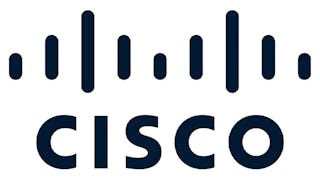Unlock the critical skills needed to design, configure, and troubleshoot MPLS VPNs on Cisco IOS platforms in this comprehensive course. You’ll gain a solid foundation starting with Virtual Routing and Forwarding (VRF) tables, the essential building block of MPLS VPN implementation. Dive deep into the key interactions between VRFs, routing protocol contexts, and MP-BGP, mastering how information is exchanged and routed in complex networks.

Enjoy unlimited growth with a year of Coursera Plus for $199 (regularly $399). Save now.

Implementing MPLS VPNs
This course is part of Implementing Cisco MPLS Specialization

Instructor: Cisco Learning & Certifications
Included with
What you'll learn
Describe the usage of VRF instances in an MPLS VPN environment, and configure VRF tables, MP-BGP, OSPF sessions between CE and PE routers
Configure small-scale routing protocols (static, RIP, and EIGRP) between CE and PE routers
Monitor and troubleshoot MPLS VPN operations
Skills you'll gain
Details to know

Add to your LinkedIn profile
July 2025
73 assignments
See how employees at top companies are mastering in-demand skills

Build your subject-matter expertise
- Learn new concepts from industry experts
- Gain a foundational understanding of a subject or tool
- Develop job-relevant skills with hands-on projects
- Earn a shareable career certificate

There are 7 modules in this course
What's included
2 readings
This module introduces the VRF table, the major data structure that is associated with MPLS VPN implementation on Cisco IOS platforms. The course describes the other MPLS VPN attributes that are associated with a VRF instance. It explains the need for routing protocol contexts and the interaction of routing protocol contexts, VRFs, and MP-BGP. Having a clear understanding of how information is exchanged using VRFs and of routing protocol contexts will make it easier to configure VRFs in your network. You will learn about the BGP process in a MPLS VPN-enabled router. You will learn about the configuration tasks, steps, syntax, and descriptions. You will be introduced to the BGP community propagation and a MP-IBGP configuration example. Most of the configuration in an MPLS VPN depends on how the PE routers are configured. Having a good grasp of exactly what is being configured and why will help greatly to ensure that your MPLS VPN network operates as smoothly as possible. You will learn how to configure VRF tables, and list the configuration tasks, syntax, and definitions of commands that are used for the creation of VRFs. You will also be provided with an example of a VPN configuration. It is important to know how to configure and apply a VRF table onto a routing interface. It is essential to understand the command syntax for the configurations that you want to deploy in your network. This course provides you with the information that will enable you to succeed at such tasks.
What's included
13 videos17 readings17 assignments
In this course, you will learn about the PE-CE routing protocol configuration steps and the various routing protocols that you can run between PE and CE routers. These protocols include RIP, EIGRP, and static routes. It is important to understand not only what you can configure between PE and CE routers when you are setting up MPLS VPNs, but also how to accomplish the configuration successfully. This course looks at the configuration parameters that you need to configure an MPLS VPN PE-CE routing exchange.
What's included
6 videos7 readings7 assignments
In this course, you will learn about the commands, syntax, and descriptions for monitoring VRF routing, MP-BGP sessions, and VPN status. It is important that you understand the network you are configuring, and that you ensure optimal network operation. You will also learn how to monitor an MPLS VPN network to ensure that the network is functioning smoothly.
What's included
7 videos8 readings8 assignments
In this course, you will learn about the PE-CE routing protocol configuration steps that are required when you are running OSPF between PE and CE routers, and the issues that can be encountered. It is important to understand not only what you can configure between PE and CE routers when you are setting up MPLS VPNs, but also how to accomplish the configuration successfully. You will look at the configuration parameters that you need to configure an MPLS VPN PE-CE routing exchange.
What's included
15 videos19 readings19 assignments
In this course, you will learn how to configure BGP as the routing protocol between PE and CE routers. It is important to understand not only what you can configure between PE and CE routers when you are setting up MPLS VPNs, but also how to accomplish the configuration successfully. This course looks at the configuration parameters that you need to configure an MPLS VPN PE-CE routing exchange.
What's included
10 videos11 readings11 assignments
In this course, you will learn about the preliminary steps for troubleshooting an MPLS VPN. You will also learn how to troubleshoot a routing information flow and VPN data flow. It is important to be able to determine what steps you should take when trying to solve a problem with your MPLS VPN network. This course describes how to correct MPLS VPN network problems.
What's included
7 videos11 readings11 assignments
Earn a career certificate
Add this credential to your LinkedIn profile, resume, or CV. Share it on social media and in your performance review.
Instructor

Offered by
Explore more from Networking
 Status: Free Trial
Status: Free TrialCisco Learning and Certifications
 Status: Free Trial
Status: Free TrialCisco Learning and Certifications
 Status: Free Trial
Status: Free TrialCisco Learning and Certifications
 Status: Free Trial
Status: Free TrialCisco Learning and Certifications
Why people choose Coursera for their career





Open new doors with Coursera Plus
Unlimited access to 10,000+ world-class courses, hands-on projects, and job-ready certificate programs - all included in your subscription
Advance your career with an online degree
Earn a degree from world-class universities - 100% online
Join over 3,400 global companies that choose Coursera for Business
Upskill your employees to excel in the digital economy
Frequently asked questions
To access the course materials, assignments and to earn a Certificate, you will need to purchase the Certificate experience when you enroll in a course. You can try a Free Trial instead, or apply for Financial Aid. The course may offer 'Full Course, No Certificate' instead. This option lets you see all course materials, submit required assessments, and get a final grade. This also means that you will not be able to purchase a Certificate experience.
When you enroll in the course, you get access to all of the courses in the Specialization, and you earn a certificate when you complete the work. Your electronic Certificate will be added to your Accomplishments page - from there, you can print your Certificate or add it to your LinkedIn profile.
Yes. In select learning programs, you can apply for financial aid or a scholarship if you can’t afford the enrollment fee. If fin aid or scholarship is available for your learning program selection, you’ll find a link to apply on the description page.
More questions
Financial aid available,

